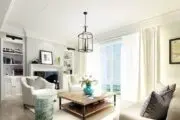
The principles behind universal design (UD) create accessible and inclusive homes that are safe, comfortable and flexible for homeowners, adding value financially and enriching lifestyle.
It’s an approach that is particularly well suited for multi-generational families, with the focus on accessibility, although there are benefits for all types of households, especially if a homeowner becomes ill, injured or disabled.
What is universal design?
Scott Pruett, co-founder of the UD Project, an advisory group with expertise in accessible and inclusive home design, defines universal design as, “design that’s as functional as possible for as many people as possible.”
Universal design is based on seven principles, where the built environment is equitable, flexible, intuitive, perceptible, safe, comfortable and appropriately sized. Design choices create spaces that are usable, safe, comfortable and accessible for all, regardless of age, physical or cognitive disability or ability.
Examples of how these principles translate into design features include single-level living, wide doorways, an open-concept floor plan, and accessible entry and exit to the home, all of which are smart futureproofing features, especially if multi-generational living might be an option.
When in the planning stages for a new build, the focus for homeowners is often on finishes and floor plan selections, but it’s smart to frame choices in the context of universal design, given the high probability that either the homeowners themselves, or their guests or family members, will require at some point in time the assistance at home that universal design offers.
Pruett says that in the United States, “Nineteen percent of households include someone with accessibility needs, and this doesn’t account for people who will have accessibility needs in the future due to age, illness, injury, etc. Further, when including friends and family into the equation, 73 percent of the population is affected by disability in some capacity.”
“Most everyone knows someone with some level of disability,” he says.
It’s possible to incorporate universal design features to support accessibility and inclusiveness, but for homeowners who might want a fully accessible home, Pruett recommends looking at home design wholistically, rather than on a feature-by-feature basis.
“We’d suggest a shift in perspective where people look at the entire home as a single product that’s either universally accessible or not. There’s a big difference between a universally designed home and a home with some universal design features,” says Pruett.
“The most common narrative is that homes can have some universal design features that make it accessible/futureproofed, but the problem is that everyone has different needs and there’s no guarantee that those features will (a) be ideal for someone or (b) be utilized throughout a home,” says Pruett.
Universal design and the multi-generational home
Multi-generational households are on the rise in the United States, having quadrupled since the 1970s, according to Pew Research. With aging in place becoming more common, household composition changing and high cost of housing, elder care and childcare, more families are making conscious choices to house multiple generations under the same roof.
This burgeoning demographic has specific design needs, and universal design is helpful in fulfilling them.
The main aspect of universal design that will make multi-generational homes most functional is: “having an option for main-level living,” according to Lori Bellport, founder of Live in Place Designs.
But if you are opting for a multi-story home, “it is imperative to have a main floor living area that can be an inclusive space for people that are aging or have health issues, “says Bellport.
“That space should include a full bathroom and a bedroom with some privacy, a kitchen and access in and out of the house safely, without stairs,” she says.
Ideally, the floor plan would have this already, or the home would have the option to convert a space to be adapted later. This could mean main-level rooms that are multi-purpose or having the option to convert or build an outbuilding onsite.
Homeowners should make sure that they have home office space located in an alternative location, as often the main floor space that needs to serve as a bedroom eventually is a home office.
Privacy is a major issue with multi-generational families, so creating zones for bedrooms, away from the communal living spaces is advisable.
Flow of traffic in households with multiple members is important. An open-concept floor plan is preferable, but also be mindful of exit and entry points into rooms. Ideally, there should be more than one access point, or have the access points be oversized, to make comfortable room for traffic flow and any assistive devices.
Universal design and new build homes
There is an opportunity for new build homeowners to plan proactively for a universally accessible home, rather than retrofitting reactively, which can be more challenging and costly.
“A lot of the design elements that you do for universal design require planning ahead,” says Kendal Cavalieri, founder and principal designer of Kendal Cavalieri Design.
“Let’s say in the future you might want grab bars or a bench seat in your shower, you need to put blocking behind the wall,” which is easier to do during the construction phase of a home, she explains.
And for homeowners who are keen to adopt universal design throughout their homes, the best option is to build new, as supply of fully accessible homes is lacking currently in the United States, something Pruett and the UD Project hope to change with community education and in an advisory capacity.
“The prevalence of existing UD homes is less than 0.15 percent, nationally,” says Pruett.
Universal design style tips
Homeowners may be surprised to learn that some of the most coveted current décor trends support the principles of universal design.
For example, the contrast in a classic black-and-white color palette not only looks stylish, but it can also help distinguish spaces and surfaces, enhancing visual perception.
“White cabinets with a black countertop are helpful in universal design. And people choose this color scheme because they like the design qualities, and not with the intent of it being for universal design,” says Cavalieri.
Smart home features simplify household item use, a key component of universal design, says Cavalieri.
“It is beneficial for someone who is disabled or has mobility issues to ask Alexa to change the temperature, rather than having to reach a thermostat. With a smart oven, you can pre-heat from your phone, and so on,” she says. Having the power to control everything from blinds to alarm systems to water temperature right from your phone is immensely helpful.
According to Cavalieri, some design choices that are viewed as luxe upgrades also promote universal design, adding both financial and functional value to a home.

- Grab bars are a necessity for safety in the bathroom under universal design but can look clinical. Well-known brands such as Koehler and Moen now feature grab bars with high-end finishes and profiles that add to the overall aesthetic.
- Specially designed toilet paper holders and soap dishes discreetly offer a grab bar function, but with a stylish twist.
- In the shower stall, a handheld shower on a slide bar is sleek and extends the shower’s functionality for people of various physical abilities.
- Wide-plank luxury vinyl flooring is an excellent choice for universal design, for its smooth finish. It’s on trend to extend flooring cohesively throughout an open floor plan, which also helps with safety and accessibility, where flat flooring and minimal transitions are preferred.
- Curbless showers elevate a bathroom’s look and are also accessible.
- Wall ovens are a kitchen upgrade, but homeowners may find them easier to use when turning or weight bearing.







